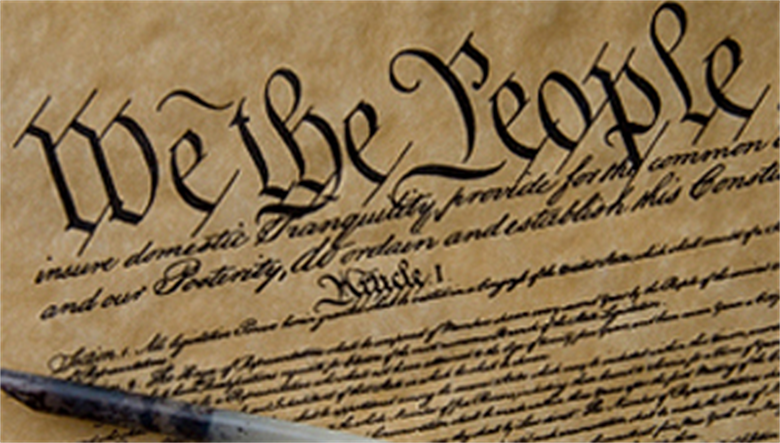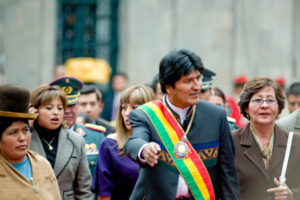The Holy Constitution


A doctored image of Parkland shooting survivor and activist Emma Gonzalez ripping the US constitution went viral recently, particularly with ultra-conservative social media users that sought to discredit the young activist. A quick glimpse at the Twitter responses on alt-right accounts that propagated the picture illustrate the disgust of Constitutional purists who believe—or rather want to believe—the veracity of the image.
The hatred towards Gonzalez and the image are indicative of many things: how quick adults are to discredit and bully a young woman, the gullibility and fragility of the internet, the state of the current gun-control debate, and, of course, the idolatry of the US Constitution. The American Constitution and Declaration of Independence have been worshipped for over two centuries. Self-branded patriots call for the preservation of America’s founding principles even in an increasingly changing and modern world. The Founding Fathers could not have possibly predicted how the world was going to change in the following 200 years thus they wrote the constitution with the knowledge of the world in 1787. For some, rules that were written in the 1780s are still completely and unchangeably applicable today. Conservative think-tanks call upon the preservation of the Constitution and often use the document to reminisce on a past era when America was at its prime. The Heritage Foundation, a conservative American think-tank, seeks “to save America by reclaiming its truths and its promises and conserving its liberating principles for ourselves and our posterity”. This conservative approach refers to the conservation of the purity of the Constitution which is reminiscent of rhetoric that was popular during the past presidential election. “Make America Great Again” is a slogan that provides an insight to this conservative rhetoric as it assumes that in order for America to assume a condition of excellence, it must go back to its core values– in this case, the commandments delineated in the Constitution.

Indeed, the Constitution is venerated as a Holy Scripture in American politics. Despite frequent references to it, however, the document is outdated and vague, thereby opening the door for loose interpretation. In fact, one of the reasons for the Constitution’s durability is its openness to interpretation. For instance, when it was written, the founding fathers disallowed for any poor men and women, let alone people of colour to vote. To this day, it does not provide clear-cut answers to issues such as women’s rights, civil rights, and LGBTQ rights. Only five countries in the world, Britain, Bolivia, Fiji, Malta, and Ecuador, give constitutional rights to LGBTQ people for example. Lack of constitutional rights puts LGBTQ people at a larger risk of rights violations and discrimination. This conundrum was seen in play in a Colorado Supreme Court case where baker Jack Phillips refused to bake a wedding cake for a same-sex couple. Phillips’ lawyers argued that it was his constitutional right to exercise the first amendment. As seen in this case, this vagueness in the Constitution allows for flexible interpretation of what was written 200 years ago and prevents reforms from being made. When the document provides answers, such as in the ongoing gun control debate, constitutional purists tirelessly quote the Second Amendment while ignoring that this was an answer given to 18th century problems. Similarly to the Bible, people pick and choose constitutional facts they want to highlight to serve their political interests. The Second Amendment, after all, is written in the same document that permitted the slavery of people “as a punishment for crime”.
One of the reasons that has exacerbated Constitutional worshiping is because the Constitution is closely tied with American identity. The United States, after all, is considered to be more than just a country; it is an embodiment of what we consider to be inherent American ideals: freedom and democracy. As the first country to implement modern democracy, this is tied with the establishment of the Constitution. Without a constitution, there would be no democratic system of governance. Thus, changing the constitution can be viewed as a rupture of the identity America was built on.
While amendments to the Constitution can be implemented, it is virtually impossible to do so. As explained by Slate: “an amendment can be proposed either by a two-thirds majority in both the House and the Senate or by a convention, called into being by Congress, after a request from two-thirds of the states. That’s version A and version B of step one. If an amendment makes it through either one, then comes step two: ratification by three-quarters of the states. In other words, an amendment requires a supermajority twice—the pig must pass through two pythons. ” This process makes it incredibly hard to implement Constitutional change. Over 11, 000 amendments have been proposed in the history of the United States, but only 27 have been enacted. The system in and of itself is broken as it does not allow for change to be implemented.
South of the US border, contrastingly, Latin American countries frequently change their constitutions to adapt to changing political tides. While it is true that a lot of these constitutional changes were made after a transition to democracy following the demise of military regimes—such as the Ecuadorian Constitution of 1978, the Brazilian Constitution of 1988, the Nicaraguan Constitution of 1987, the list goes on and on— it is indicative of a trend of flexibility. Generally, there is no constitution worshipping in Latin America. While there are some exception to this rule, such as the case of Mexico which has had the same constitution since 1917, various countries count more than two dozen constitutions. In the last 20 years alone, a number of countries have created new constitutions: Venezuela, Brazil, Bolivia, Ecuador, among others. If something is being perceived as inefficient or undemocratic, a proposal to change or redraft the constitution can be put into place. These constitutional changes can bring about more inclusivity within the democratic process. For example, President Evo Morales of Bolivia enacted the 2009 Plurinational Constitution–the 19th in history–which gave more recognition and institutional power to indigenous peoples. This was a significant step towards the recognition of indigenous people in Bolivia. This is especially the case given that indigenous Bolivians were long denied full political and social rights notwithstanding the fact that they’ve represented the majority of the population, as the new constitution gave them explicit autonomy and rights in a country that has excluded them from having full citizenship rights.

Nevertheless, it is important to note that these constitutional changes are not always so benevolent. Following the case study of Bolivia, President Morales was recently looking to bend the words of his own constitution to allow for his third reelection (which is against the constitution). With 19 constitutions, this is not to say that Bolivia is an example to follow in the field of political stability or that all countries should change their constitutions whenever they please. It is indicative, however, of a country aiming to modernize an unjust constitutional system. While the case of Bolivia could be simply interpreted as the success of indigenous mobilisation after years of political instability, the applicability of the new constitution is still indicative of a desire to change the old ways. The referendum implemented to apply the constitution is indicative of this. In order for the 2009 constitution to be put in place, it had to go through a national referendum. The Bolivian Constitution was approved by 61.4% of voters with a voting turnout of 90%. These numbers are indicative of the citizenry’s active political participation which is a positive variable of political change.
The truth is that a constitution on its own is not going to solve a country’s problem as the complex political arguments of today will seldom be resolved by a document that, in the case of the United States, was written in the 18th century and in the case of Bolivia, often changes. It is important, however, to examine how we look at constitutions critically: either as disposable documents or as worshipped papers. “We’ll keep clinging to our Constitution, our guns, and our religion,” Sarah Palin said during a rally in 2011, “and you can keep the change.” This quote is indicative of an entrenched Republican attitude regarding constitutional change. Nevertheless, the truth is that constitutions and constitutional change must be looked upon critically. The solution advocated is not to modify the constitution every time a new administration comes to power, but to listen to the demands of the people. A constitution that was written in a pre-industrial revolutionary society is not an accurate ruling document for the modern times. Constitutions are meant to be changed and adapted to the changing times. Constitutions, after all, are the words of men, not gods.
Edited by Luca Loggia
